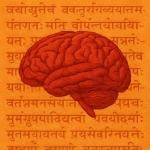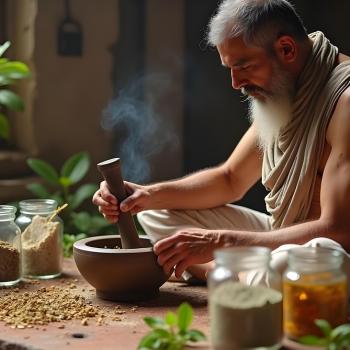Why?
Rising from his bed in the morning, a typical practicing Hindu begins his day by first praying to Pruthvi Mata (Mother Earth) before placing his foot on the earth reciting this shloka:
समुद्र वसने देवी पर्वत स्तनमण्डले !
विष्णुपत्नी नमस्तुभ्यं पाद स्पर्शं क्षमस्व मे !!
samudra vasane devi parvata stanamanDale !
viShNnupatni namastubhyam pAda sparSham kshamasva me !!
It means ‘Hey (Devi), the one residing in the ocean, whose breasts are the mountains; the consort of Bhagwan Vishnu, kindly pardon me for touching you with my feet.’
Does this shloka imply some adhyatmik (spiritual) meaning to what we consider as “Earth’?
This is what our Rishis wrote for us to revere our Earth.
Thousands of years earlier, Vedic Rishis discussed Earth’s role in the Brahmanda (cosmos), not just as a planet, but as a sacred, living force. Earth is NOT viewed as an inanimate or non-living entity nor an entity merely for our consumption. And, it is self-sustaining too provided we behave with responsibility.
Over 5,000 years ago, the Bhumi Suktam from Atharva Veda spoke of Prithvi (Earth), and Bhumi- the steady, life-sustaining Mother.
It lists 8 factors that keep the earth sustainable for living. It says that earth creates a stable platform for our experience of life.
Our rishis saw Earth not as separate from space, but as part of it.
They saw it not just as matter, but as Shakti (energy), not just land, but as Devi, Bhu (land) Devi.
Our body and in fact all the creations of Brahman/Paramatma (Superconsciousness) are composed of five elements; Earth, Agni (fire), Water, Vayu (air) and Akash (ether).
As the world celebrates Earth Day, we remember that reverence for Earth isn’t new to us. It’s rooted in our sanskruti, our parampara (tradition).
Of course, today we have much to re-learn what we have forgotten for whatever reasons that was handed over to us by our rishis over a period of thousands of years.
Hopefully, we would realize that we need to recover from the collective amnesia.
Earth Day Today

The first ‘Earth Day’ was celebrated on 22nd April, 1970, thanks to the Moon Mission carried out by NASA, when for the first time Humans saw what the Earth looked like from space.
It is gratifying to note that the Western society has understood the need for sustainable living and recycling of the waste material, even if it is not connected with sacredness. This is greatly helpful for the environment. It has realized that the resources that our Mother Earth provides are not unlimited, and hence this day is celebrated every year as Earth Day.
Unfortunately, present-day environmentalism, however, is based on the Western anthropocentric approach. Anthropocentrism as a religious and philosophical doctrine holds that ‘only human life has intrinsic value while other entities (including animals, plants, mineral resources, and so on) are resources that may justifiably be exploited for the benefit of humankind.’
Making movies like ‘Avatar’, ‘Moana’ etc. reflect that they are willing to adapt and accept ideas from other civilizations that have the traditions of living in harmony with nature.
Spiritual Aspects as per Hindu Dharma
However, our shastra-s have proclaimed reverence for all creations of Brahman.
We all know that Hindus worship rivers, mountains, trees, animals, earth, in fact all life forms.
In Mahabharat, there is a conversation between Yudhishthir and Bhima when they were in exile. Once when Bhima was indiscriminately chopping a tree, Yudhishthir told him to be careful in cutting the same. He suggested that from nature one should take only for one’s need and not for his greed.
In our shastra-s, one would find hundreds of teachings about respect and reverence for all creations of nature.
We always believed in the transcendence of Brahman in all the elements of nature.
What is considered modern and scientific in our day-to-day lives today, is based primarily on Western thought of progress. Lest I be labelled as a neophobe, we do need technology which has helped us much in almost every aspect of life. However, our mindset that we have right to comfortable or luxurious living at any cost needs to be revisited. Under the guise of the rubric of development, exploitative ruthless consumerism has been justified by modern age humanity.
Such thinking was unknown to Hindus as well as to the non-Western civilizations. Hinduism has a long history of living in harmony with their surroundings. They were always aware of their responsibilities towards nature and knew where to draw the line. They seldom crossed the boundaries. Hindus as well as the native cultures across several civilizations had and still have a complex system of using and preserving the ecology.

Bhoomi Suktam: Ancient Framework of Environmentalism
As for Hindus, much before any modern-day environmental protocol was ever signed, it is the Bhumi Suktam (hymn of the Mother Earth) that provided a framework for environmentalism, considered to be the oldest text on this subject.
सत्यं बृहदृतमुग्रं दीक्षा तपो ब्रह्म यज्ञः पृथिवीं धारयन्ति ।
सा नौ भूतस्य भव्यस्य पत्न्युरुं लोकं पृथिवी नः कृणोतु ॥१॥
satyam Brhad rtam-ugram dIkShA tapo brahma yajnyah prthivIm DhArayanti |
sA no bhUtasya bhavyasya patny-urum lokam prthvI nah krnotu ||1||
Salutations to mother earth! the truth (satyam), the cosmic divine law (ritam), the spiritual passion manifested in mighty initiations, penances and self dedications to the search of Brahman (by the sages); these have sustained the mother earth for ages (who in turn have supported these in her bosom), she, who is to us the consort of the past and the future (being its witness), may she expand our inner life in this world towards the cosmic life (through her purity and vastness).
The Suktam is composed of 63 verses. These verses provide a foundation of understanding as well as respecting Mother Earth and her environment. The Suktam recognizes the Earth for all her gifts such as plants and herbs; rivers and land including the cultivable land for food; and animals for milk, honey, etc. But going a step further, the invoker of these mantra-s declares that despite availing all those boons, he does not intend to hurt Mother Earth in any manner whatsoever. The Suktam gives Mother Earth an assurance of rational utilization of her resources.
We also find more shlokas in Bhu Suktam (Taittirya SamhitA) as well as Bhu Stuti (composed by Swami Desikan) that hold reverence for Mother Earth.
As per our shastra-s, much of our interaction with the elements of nature is guided by our Dharma: the rules of ethical behavior. Such behaviors are guided not by rights, but by responsibilities, by obligations.
The objective is ‘to generate and spread reverence for humans, animals, trees, earth, nature, and the entire universe in general.’
Our shastra-s teach us to live in harmony with nature.
So, let us honor not just the Earth, but also the Bharatiya thought, the Bharatiya philosophy that saw Her deeply and wisely, leading to sustainable living across thousands of years.
Astu
Udit Shah












